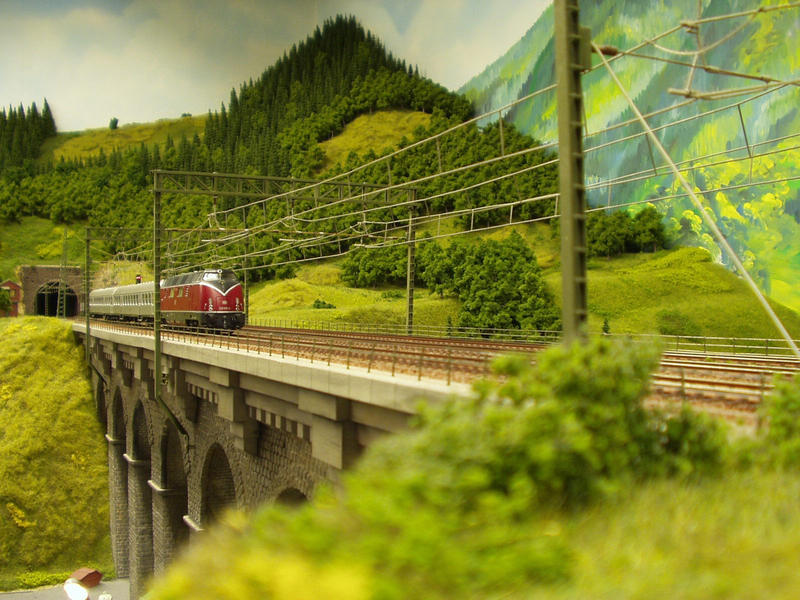Crack open any one of several older Marklin catalogs and the pages are adorned with pictures of a plethora of trains crisscrossing a layout which, in some cases, is also featured in the catalog’s center, complete with track plan. The same can be said for the European manufacturers’ presentation layouts at events and exhibits. Generally these layouts exist, as a primary purpose, to showcase the model trains the manufacturers have produced. In other words, they are train layouts, relying less on scenery and more on tracks and trains. Sure, there are buildings and mountains, but generally they are secondary to the trains themselves. On the other hand a model railroad defines itself by reproducing the railroad prototype in miniature. There is nothing wrong with wanting to run as many trains simultaneously as possible- it is what train layouts are designed for. But for those who are in the planning stages of a layout and who are struggling to be less train layout and more model railroad, read on for a few suggestions to keep in mind for designing a dream layout while still following a “less-is-more” philosophy.
Our hobby, like so many others, is an evolution. The more we do, the more mistakes we make, the more we learn. Unfortunately this isn’t like knitting, where we can try over and over again to ‘get it right’. But with every trip to Europe or every episode of ‘Eisenbahnromantik’ I watch on Youtube I get just a little bit smarter on the minutiae of European railroads. Unfortunately that leads to new ideas and new desires when it comes to replicating those into a smaller scale. With these tips hopefully you can join me in making sure that at least at the track planning stage the result is a little more ‘railway’ and a little less ‘train’…
- Manage Your Expectations. A full-length Thalys needs about twenty feet to be enjoyed in its entirety as it races across an HO-scale countryside. The busiest lines in Switzerland have trains passing roughly every 5 minutes. If your available space (and budget) don’t allow for getting even close to those numbers then consider dropping the main line as your layout’s focal point and focus instead on a branch line. Watching a train chase its tail gets old quickly, and those Viking cars will never be able to cross the tracks when the crossing gates are down more time than they are up.
- Design for ‘Creative Realism’. The Internet has an unlimited number of European railway images. Books by the dozen help with prototypical modeling. Google Earth provides access to almost every railway line/station in Europe. However trying to replicate a prototype exactly in your chosen scale is usually not a good solution. Instead, use prototypes as guidelines and compromise as needed to increase your layout’s entertainment value. That big-city terminus station will keep you just as busy and entertained with a few less tracks than the prototype.
- Flex track is your friend. Even R5 curves are too tight to be realistic on any main line. When possible, keep all fixed radius track hidden in tunnels. If it’s absolutely necessary to use sectional track in a visible area then try and keep your curves short, with no curve more than 15 degrees. If necessary, cut track (yes, even if it has roadbed) to make your curved sections shorter for a more slender look.
- Embrace the third dimension. When planning your layout consider the added benefits of going above and below the ‘station’ level. Hidden staging yards, visible freight yards, and parade sections of main line are perfect for going one or two levels down. Commercial helix kits are available, or consider a completely independent loop of track above or below your main layout. Multiple levels provide a natural ‘break’ between areas of track and make the layout feel less crowded. Putting stations on two different levels and at opposite ends of the layout provide more of a ‘from-here-to-there’ feel. My current layout design includes two staging yards, one below the other, and both of them below the main station. The bottom level is a mere three feet off the ground!
- When All Else Fails, Change Your Scale. To many of you this will sound sacrilegious. I have been a die-hard 1-scaler (1:32) for nearly twenty years, and although our new house has a decent basement for a 1-scale layout, I’m contemplating switching back to HO, the scale of my childhood. Why? Because of what I’d like to accomplish on my next layout, including the afore-mentioned Thalys run. A few years ago when I had zero space for even a modest HO layout I built a layout in Z-scale, which I enjoyed thoroughly. Don’t rule out the possibility of switching scales, either until available space changes or for good.
Our hobby, like so many others, is an evolution. The more we do, the more mistakes we make, the more we learn. Unfortunately this isn’t like knitting, where we can try over and over again to ‘get it right’. But with every trip to Europe or every episode of ‘Eisenbahnromantik’ I watch on Youtube I get just a little bit smarter on the minutiae of European railroads. Unfortunately that leads to new ideas and new desires when it comes to replicating those into a smaller scale. With these tips hopefully you can join me in making sure that at least at the track planning stage the result is a little more ‘railway’ and a little less ‘train’…



 RSS Feed
RSS Feed